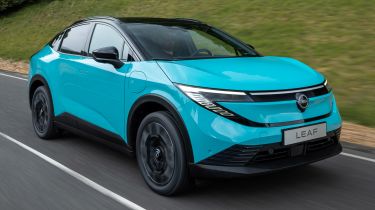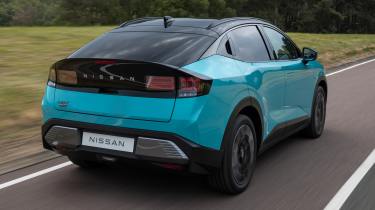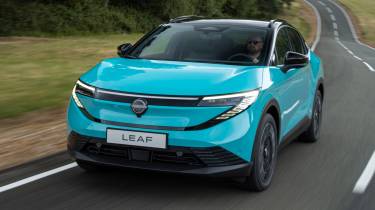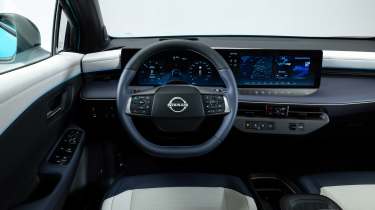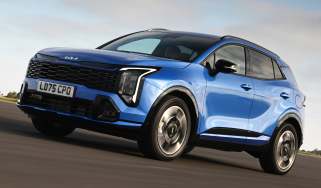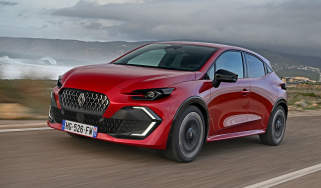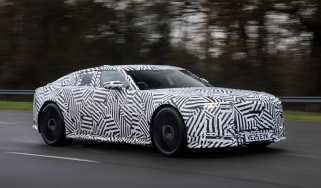New Nissan Leaf: British-built EV enters production in Sunderland
On sale now, the sleek new Leaf is one of the very few models to qualify for the full £3,750 grant from the UK Government
The Nissan Leaf has just entered full-scale production at the Japanese brand’s plant in Sunderland, with the electric SUV already on sale from £32,249 and first deliveries expected in early 2026.
At launch, only one version of the Leaf is available, boasting a 75kWh battery and up to 386 miles of range – a fair bit more than similarly priced rivals such as the Volkswagen ID.3 and the award-winning Skoda Elroq which, at this price point, only have around 250 miles of range.
The Leaf’s appealing price largely comes down to the fact it’s built in the UK and is thus deemed sufficiently eco-friendly by the Government to benefit from the full £3,750 Electric Car Grant (ECG). With this in mind, the electric family SUV is set to be a big seller – a good thing, given that Nissan has already invested more than £450 million into the Sunderland plant and its 6,000-strong workforce.
Business and Trade Secretary Peter Kyle said: “Sunderland is the beating heart of the UK’s automotive industry, and Nissan’s investment is a major commitment to the North East and a huge vote of confidence in our economy.”
Prices and specs in detail
There may only be one powertrain on offer at the moment, but the new Nissan Leaf is available in four trim levels: Engage, Engage+, Advance and Evolve. The base model is equipped with 18-inch alloy wheels, dual 12.3-inch displays, wireless Apple CarPlay and Android Auto, an energy-saving heat pump and adaptive cruise control.
Engage+ starts from £33,149 after the ECG and adds larger 14.3-inch displays with Google Maps and other Google services built-in, heated front seats, a heated steering wheel and a wireless charging pad.
Upgrading to Advance trim (starting from £34,249 after the ECG) piles on luxuries including a panoramic sunroof, head-up display, powered tailgate, synthetic leather upholstery with fabric inserts and privacy glass.
Finally, the range-topping Evolve model (starting from £36,249 after the ECG) gets 19-inch wheels, a nine-speaker Bose sound system, Vehicle-to-Load charging capability, eight-way adjustable front seats with massaging function for the driver and full synthetic leather upholstery.
Aside from the new Leaf, the only other electric cars that have been confirmed as eligible for the full £3,750 EV grant are the Ford Puma Gen-E and E-Tourneo Courier, and the long-range version of the Citroen e-C5 Aircross. Since the ECG was introduced in July, it’s helped more than 35,000 motorists make the switch to electric.
This also means Nissan’s entire EV line-up is eligible for the ECG, with the new Micra supermini and Ariya family SUV both receiving £1,500 from the Government. But you can currently save close to £5,000 on the Ariya if you spec it through the Auto Express Buy A Service.
Range, performance and charging
We were told the Kia EV3 and Volkswagen ID.3 were the two key competitors that Nissan had its eye on when developing the new Leaf, looking to appeal to both the short-range urban dweller and high-mileage business users.
The long-range 75kWh unit gives the Leaf its impressive 386 miles of range – or 269 miles of purely motorway driving – which trumps both the EV3’s and ID.3’s best efforts. That battery feeds power to a front-mounted 214bhp electric motor and will go from 0-62mph in 7.6 seconds, meanwhile topping up the battery from 20 to 80 per cent will take less than 30 minutes.
The entry-level model will use a smaller 52kWh battery good for around 270 miles from a charge, or roughly 140 miles just on the motorway. This version also uses a slightly less powerful 174bhp electric motor, but can still do 0-62mph in 8.6 seconds and hits the same 100mph top speed. And while the max charging speed drops from 150kW to 105kW, it should still only take half an hour to top up from 20 to 80 per cent.
Sleek, aerodynamic design
A big battery is only one of the elements required for long range figures, and Nissan’s designers have worked hard to make the Leaf into a much more slippery and efficient EV. The sloping roofline, Kamm-tail rear end and clever aero tricks around the front contribute to an impressive drag coefficient of just 0.25 – excellent for the class and better than many key rivals.
The sloping roofline has also been a key driver of change when it comes to the car’s overall form, with vice president, Nissan Design Europe, Giovanny Arroba explaining to Auto Express about the latest model’s design philosophy. “The Leaf is all about muscularity, wheel orientation, agility, but it should still have a sense of chic, urban, sleek and sexiness,” he said. “The shape of the Leaf very much is again, shaped by bringing 604 kilometres [of range] to the customer within that price range.”
Nissan has also sprinkled in plenty of nineties-inspired design details, which was a heyday for the brand. Elements such as three-dimensional rear lights and their clever ‘Ni-San’ (or two-three in Japanese) graphics, plus references to sports models like the 300ZX around the blacked-out rear panel, all suggest that the company is leaning into something the newer Chinese and Korean brands don’t have: heritage.
It might appear like a big car, but pictures don’t quite do the Leaf justice, because it’s one of very few EVs that looks smaller in the flesh. At 4,350mm long, it’s only around 50mm lengthier than the boxy Kia EV3.
Interior, practicality and boot space
The cabin’s interior design is much more contemporary, with the clean and uncluttered dash layout prioritising a digital-heavy interface, but without totally relegating physical controls to the bin.
The twin-screen display on all but the base model is new for Nissan, featuring dual 14.3-inch screens that are even bigger than the Ariya’s. They also run a fresh native interface that’s powered by the latest electronic hardware, and include elements such as intelligent voice control and a Google-based navigation system.
Just below the main screen bank is a set of touch-sensitive controls for the air-conditioning, and between the air vents are a simple volume knob, track-seek buttons and a shortcut for the parking cameras. High-spec models will also feature a Bose sound system, including a dedicated speaker that can relay navigation and warning sounds to the driver without interrupting passengers.
The rear seats are spacious for the class, with good knee and legroom. A flat floor means foot room is decent, while there is plenty of headroom, despite the sloping roofline. Nissan will offer a glass roof on higher-specification models, which includes the same changeable glass that can block sunlight across the roof in stages. As well as making the cabin brighter, the glass roof also increases rear headroom by 30mm.
There’s plenty of space in the cabin, with good storage for small items combined with a vast, open area under the dashboard to really hammer home that this is a bespoke EV, rather than one based on an existing ICE platform. The 437-litre boot is also a good size and is 50 litres bigger than the previous-generation Leaf. However, more upright rivals will likely be more versatile when it comes to loading bulky items.
Auto Express Find A Car can help you find the best deals out there on used Nissan Leaf models...
Deals on Nissan Leaf alternatives
Find a car with the experts

